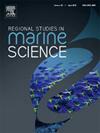Applying artificial intelligence to predict the fishing performance of stow net constructed with noctilucent sticks
IF 2.1
4区 环境科学与生态学
Q3 ECOLOGY
引用次数: 0
Abstract
The application of artificial light to attract marine organisms was demonstrated to enhance fishing gear efficiency. This study presented a novel stow net design incorporating noctilucent sticks to optimize catch performance. Specifically, the research examined the impact of different colores of noctilucent sticks on the efficiency of catch in stow nets. The results revealed the use of noctilucent sticks could significantly increase the catch weight of stow nets (p < 0.01). Notably, the color of the noctilucent sticks influenced their effectiveness, with olive green sticks increasing catch weight by 40.65 %, followed by azure sticks (12.57 %) and bluish green sticks (8.88 %). The predominant species caught was the small yellow croaker, whose catch proportion rose from 19.18 % to 22.80 % due to the noctilucent sticks. In addition, a comprehensive analysis was conducted using the generalized additive model (GAM) to assess the impact of noctilucent sticks, lunar phases, and tidal cycles on stow net catch weights, complemented by a backpropagation (BP) neural network for predictive modeling of catch weights. It was confirmed that lunar phase, tidal cycle, and noctilucent stick presence significantly affected stow net catches. While the BP neural network predictions closely matched the measured data, with the accuracy exceeding 89.63 % and 91.72 %. This study provided theoretical guidance for stow net fishing practices in the Yellow Sea.
应用人工智能预测夜光棒筑网的渔捞性能
应用人工光吸引海洋生物,可提高渔具效率。本研究提出了一种采用夜光棒的新型捕鱼网设计,以优化捕鱼性能。具体来说,该研究考察了不同颜色的夜光棒对渔网捕捞效率的影响。结果表明,使用夜光棒可显著提高拖网的捕获重量(p <; 0.01)。值得注意的是,夜光棒的颜色影响其效果,其中橄榄绿棒增加捕获重量40.65 %,其次是天蓝色棒(12.57 %)和蓝绿色棒(8.88 %)。夜光棒的作用使小黄鱼的渔获率由19.18 %上升到22.80 %。此外,利用广义加性模型(GAM)进行了综合分析,评估了夜光棒、月相和潮汐周期对渔获物重量的影响,并利用反向传播(BP)神经网络对渔获物重量进行了预测建模。月相、潮汐周期和夜光棒的存在对渔获量有显著影响。而BP神经网络预测与实测数据吻合较好,准确率分别超过89.63 %和91.72 %。本研究为黄海慢网捕鱼提供了理论指导。
本文章由计算机程序翻译,如有差异,请以英文原文为准。
求助全文
约1分钟内获得全文
求助全文
来源期刊

Regional Studies in Marine Science
Agricultural and Biological Sciences-Ecology, Evolution, Behavior and Systematics
CiteScore
3.90
自引率
4.80%
发文量
336
审稿时长
69 days
期刊介绍:
REGIONAL STUDIES IN MARINE SCIENCE will publish scientifically sound papers on regional aspects of maritime and marine resources in estuaries, coastal zones, continental shelf, the seas and oceans.
 求助内容:
求助内容: 应助结果提醒方式:
应助结果提醒方式:


